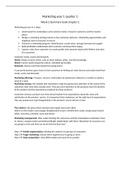Samenvatting
Marketing and sales samenvatting chapter 1, 20 (p.611, 612), 8, 7 (199,200), 14, 10, 12, 3, swot theory
- Instelling
- Avans Hogeschool (Avans)
Summary of the book, powerpoints and lectures of international marketing ans sales from international business avans Breda year 1 quarter 1. Chapter 1, 20 (p.611, 612), 8, 7 (199,200), 14, 10, 12, 3, swot theory
[Meer zien]





